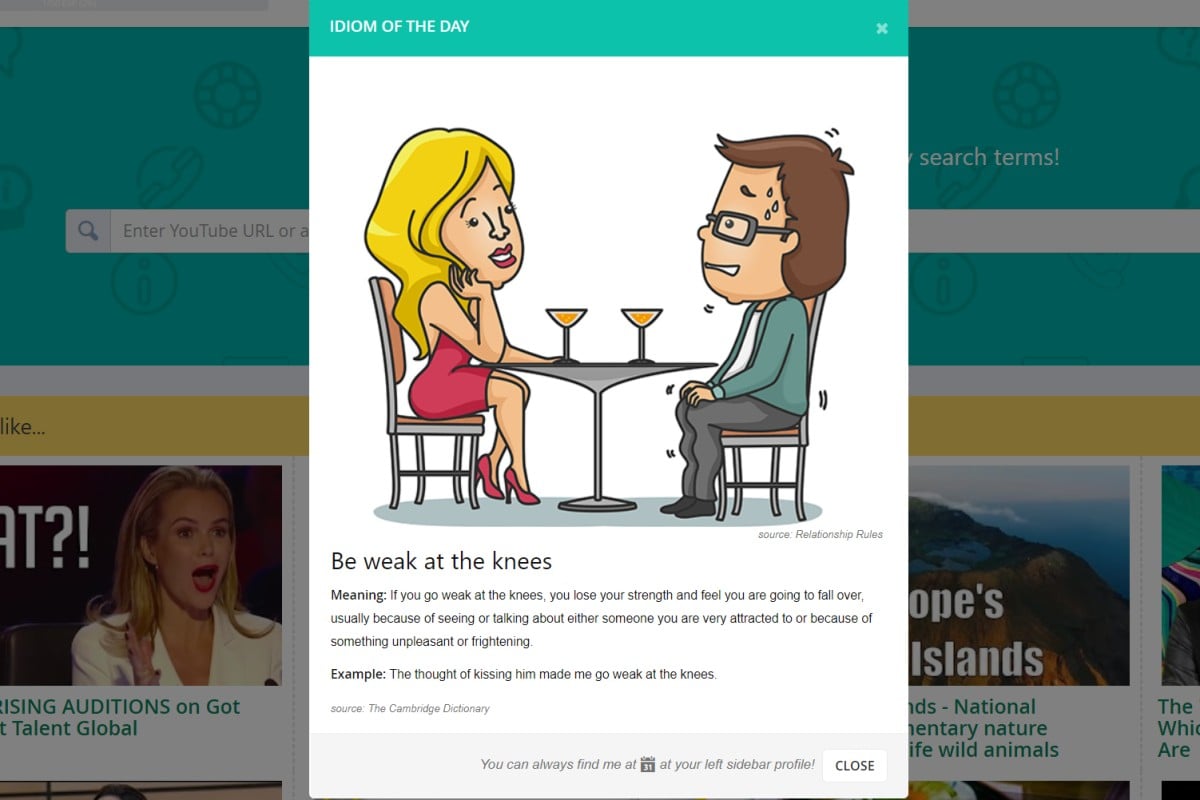
This online learning tool teaches idioms with YouTube videos to help you master the English language like a native speaker
Polytechnic University linguist Phoebe Lin’s new website allows users to learn English phrases while watching their favourite YouTube videos
 A new “idiom of the day” will pop up on the screen when you log in.
A new “idiom of the day” will pop up on the screen when you log in.Watching videos on YouTube is something most of us do at least once a week, if not several times a day. Usually, it’s simply a way to pass the time, but linguist Phoebe Lin sees videos as powerful language learning tools. And she isn’t just talking about educational videos; she wants people to be able to pick up typical English phrases – or idioms – while they’re watching their favourite YouTubers and talk shows.
“Idioms are very common in everyday language; research has even shown that more than half of our everyday speech is made up of them,” says Lin, a research assistant professor from the department of English at Polytechnic University (PolyU). “So it’s very important to master idioms if you want to sound like a native English speaker.”
That’s why Lin founded IdiomsTube, a online tool which can detect the use of idioms in videos. It’s the first of its kind in the world, and it is totally free.
23 time idioms to make your writing more interesting
After two years of research and building, Lin and her team launched IdiomsTube last month; the platform already has more than 300 users, but that number is rapidly growing.
To create the platform, Lin combined her English expertise with her research into Artificial Intelligence (AI) and data analysis. IdiomsTube uses language processing technology which can convert words into data; this is how the system is able to detect phrases so quickly.
The site now has around 50,000 idioms and phrases in its database. It can even detect famous quotes.
29 clichés to avoid to improve your writing
Searching and watching
At first glance, IdiomsTube is like any other video platform. You can find a video by typing a term into the search bar. The system will then filter through all the English videos on YouTube that have user-uploaded subtitles, and find the ones that match your search terms. If you already know what video you want to watch, you can paste the YouTube URL directly into the search bar.
The system uses YouTube’s interface and layout, which means that when you watch a video on IdiomsTube, it’s no difference to watching it on YouTube. There are also functions that allow you to change the speed of the video, and show or hide the subtitles.
Exercise
After watching a video, you can press the “Let’s Begin Exercise” button.
The system will scan and pick up any idioms from the subtitles of the video it just played. If the video has more than five idioms, the system will choose the five most important ones.
“We prioritise the idioms that are most frequently used around the globe, or those which are longer or have more difficult words,” explains Lin.
How to proofread your essays like a boss, with tips from a professional editor
When users click on the idioms, they will be given definitions and example sentences. The platform sources its definitions from 17 different online dictionaries, including the Oxford and Cambridge dictionaries. It is also linked to sites which list famous quotes.
Next, users will be given five multiple-choice questions related to the video script. Users need to select the correct idiom to fill in the blank in each sentence.
If they need a little help, they can press the “Play Video” button, which will take them to the point in the video where the idiom is used. Learners will then receive a score at the end of each exercise.
How to write a fantastic story
Personalised dashboard
Users can track their progress with the help of a personalised dashboard on their account, which tells them how many new idioms they’ve learned. There is also a leader board that shows the rankings among users globally. Teachers can create group leader boards for their students, too.
Lin wanted to find as many ways as possible to encourage learning; so when users reach a certain score, they can unlock different rewards.
The dashboard even has flash cards so that users can revise idioms they’ve learned in the past – and the system knows exactly how often you should be revising.
Top 5 dictionary apps for English learners
“To fully master the use of a word or a phrase, you have to look at it several times,” explains Lin.
“We record when a user encounters an idiom, and provide them with a revision method that is scientifically proven to be useful … and as everyone watches different videos, they will see different flash cards.”
Idiom Diary
This is a collection of all the idioms a user has encountered so far. When you click on each idiom, their meaning, example sentences and videos they appear in will pop up. Idioms will also be placed into one of four categories: Bookmarked Items, Most Seen, Good Job and Need to Work on.
20 useful food idioms to spice up your writing
Idiom of the Day
Every day, when users log in to IdoimsTube, a new “idiom of the day” will pop up on the screen. Each phrase is generated based on the user’s performances in the video exercises. Most of the daily idioms come with animations, definitions and examples are also provided.
Research
To see if this platform really works, Lin and her team started collecting data in November with users who sat a test before they started using IdiomsTube. In three months, users will be asked to do the same test again. The team will also be doing a controlled experiment with 30 students whose English abilities will be tested once after they learn English through watching videos, and then again after learning through reading texts. Their results will then be compared to determine which mode of learning is more effective.
While these tests are ongoing and their results pending, the IdiomsTube team couldn’t be prouder of what they’ve achieved. “We’ve created a personal self-learning experience,” Lin says.
